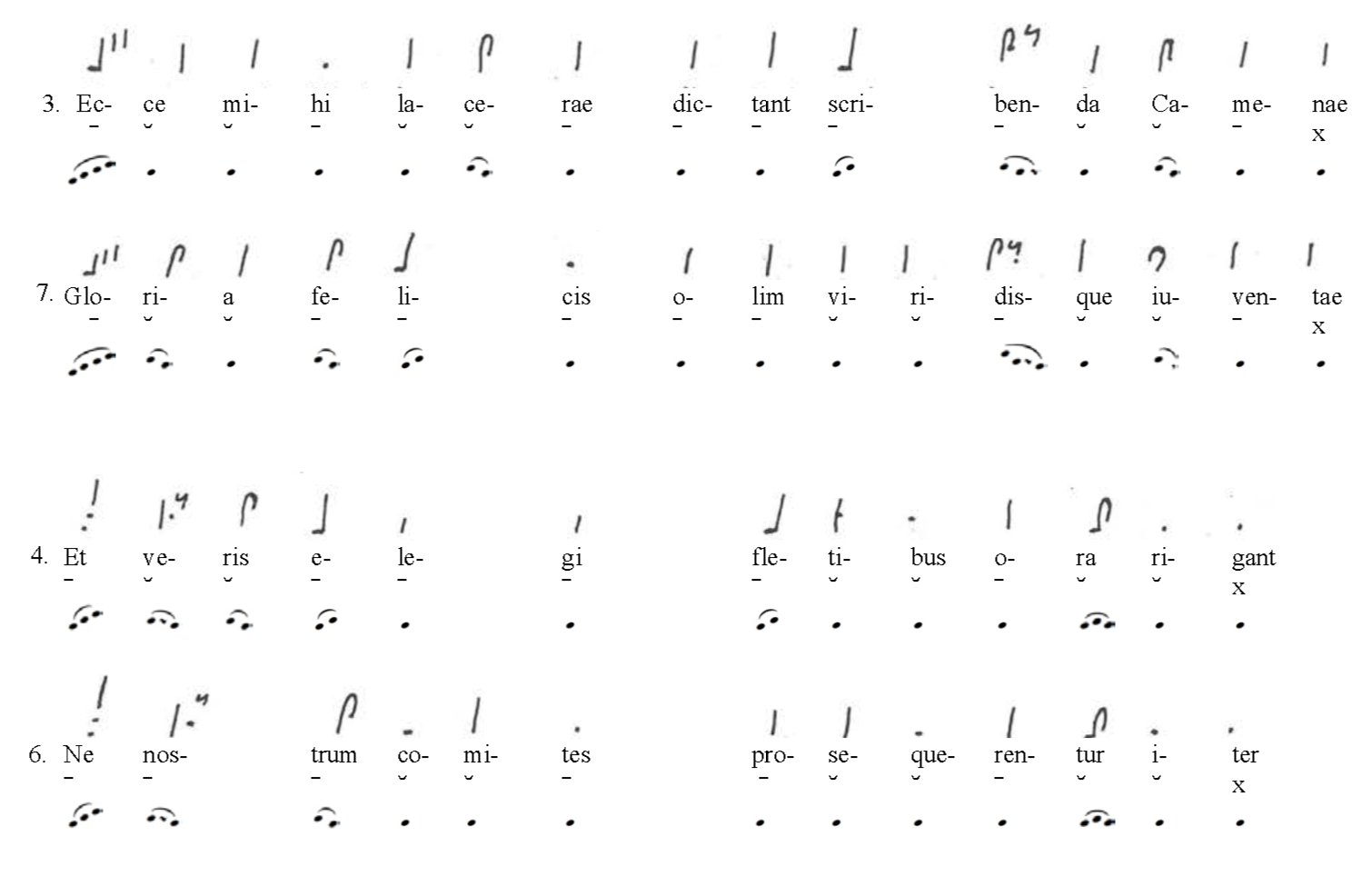A pdf of this explanation may be downloaded here.
The De consolatione philosophiae opens with Boethius lamenting the state into which he has fallen. In eleven elegiac couplets (i.e. dactylic hexameters followed by pentameters), he compares his sorrowful songs of advanced age to the songs of his contented youth, blaming the wiles of Fortune for his downfall.
Notation was added in the Cambridge leaf to the opening 8 lines of the 22-line poem, which was written out in full. The neumes alone indicate a distinctive melodic profile. The following remarks refer to the example below, in which notations are aligned for hexameter lines 3 and 7, and pentameter lines 4 and 6; scansion signs are placed beneath each syllable to indicate metrical quantity, and stemless noteheads clarify the basic information transmitted by each neume about discrete pitches. Each line opens with an initial rise in the melody represented by signs placed in a rising trajectory over the first syllable. This opening rise is followed by a flexible pattern of ascents and descents indicated by signs in the shape of crooks (two descending tones or a clivis) and ticks (two ascending tones or a pes). This sequence of varied length ends in a single tone at the mid-point of the verse line, which corresponds to a fixed break or caesura in the verse after two and a half dactylic feet, i.e. - ⏕ | - ⏕ | -. Towards the end of the line, the neumes indicate cadential patterns that begin at the point that the text enters into a fixed metrical and accentual pattern, namely 5 syllables from the end of the line in the odd-numbered dactylic lines and 7 from the end in the even-numbered pentameter lines.
This way of singing a text corresponds to principles of recitation used in psalm singing, for which formulae known as Tones were used to chant verses of varying length. By way of illustration, the words of the first two verses of Psalm 94 are set below to a standard formula known as Tone 2 taken from an early tenth-century treatise on psalmody known as the Commemoratio brevis.[1] Each psalm verse is split into two parts around a central caesura. After a rising intonation there is recitation on a single tone, followed by a pattern of descending and ascending two-tone figures five or six syllables before the caesura depending on whether the final accent is penultimate or antepenultimate. Following the caesura, a new falling and then rising two-note intonation leads to further recitation on a single tone before a cadence fixed four syllables from the end that returns from the recitation tone to the final.
It is fitting that a method of reciting psalms was applied to Carmina qui quondam as the texts of psalms and elegiac couplets share a number of traits. Both feature a variable number of syllables before and after the poetic caesura in the middle of the line. In Carmina qui quondam there are between 12 and 17 syllables in each line, divided roughly equally around a fixed caesura after two and a half dactylic feet. In Psalm 94, there are 28 syllables per line on average, with an average of 16 syllables before and 12 after the caesura at the mid-point.
Individual neumatic signs used by the notator of the Cambridge leaf provide hints about specific pitches. The sign found at fletibus in line 4 and mesti in line 8 is unusual in featuring a diagonal stoke (known as a virga) with a small dash in the middle on the right-hand side. The meaning of this sign is clear from its appearance in another mid-11th-century Anglo-Saxon manuscript from Canterbury, where it corresponds with the pitch ‘f’ or “fa” (i.e. the upper pitch at the semitone step, “mi-fa”).[2] Other hints about relative pitch are transmitted by a number of different means. The diagonal single-note signs in line 1 have ascenders of different length; it is clear from uses of this sign in contemporaneous Anglo-Saxon chant notations that the longer the ascender, the higher the pitch.[3] The disposition of signs in relation to each other across the page also provides a certain amount of indication about relative pitch: signs placed relatively high in the available space typically indicate higher pitches. A conventional distinction is also drawn between single notes represented by diagonal strokes (virgae), which indicate a relatively high note in relation to those surrounding and are frequently also used to record monotone recitation, and single notes represented by dots, which indicate relatively low tones.
Of the eight psalm tones that correspond to the eight modes used to categorize Gregorian chant, the psalm tone that fits most closely to the melodic profile sketched by the neumes added to Carmina qui quondam is Tone 2. Even once a melodic principle has been identified for Carmina qui quondam, the working out remains open to interpretation. The realization of psalm tones differed depending on the level of solemnity of the occasion; a psalm sung as part of the daily Office would be chanted in simpler fashion than one sung in the Mass; in this case, the level of complexity is closest to the elaborate form used for psalms chanted during the Mass. A number of decisions also remain in extending the recitational principle used for single verses of psalms across a poetic couplet. Here an ouvert/clos or open/closed relation as found in many medieval song traditions has been used. The first line has an open cadence that returns to the recitation tone, a decision prompted by the use of two virgae indicating relatively high tones on the final two syllables in the line. A closed cadence on the final is reserved for the end of the couplet.
The melody proposed here serves as one possible realization within a relatively narrow set of options afforded by a Tone 2 recitation and the range of clarificatory pitch information provided by the neumes. The principles recorded in the notation for lines 1-8 have been extended across the whole text of the metrum, an extension implied by the copying of the complete poem at the opening of the Cambridge Songs leaf.
A version of the explanation above was first published in Sam Barrett, ‘Creative Practice and the Limits of Knowledge in Reconstructing Lost Songs from Boethius’s “On the Consolation of Philosophy”’, Journal of Musicology 36.3 (2019), pp. 272-74. On the wider notated tradition for this metrum, see further, Sam Barrett, The Melodic Tradition of Boethius’ De consolatione philosophiae in the Middle Ages, 2 vols. Kassel and Basel: Bärenreiter, 2013, vol. I, pp. 110-15 and vol. II, pp. 191-3.
[1] Commemoratio brevis de tonis et psalmis modulandis (A Brief Review of the Modes and Psalm Singing), no. 22, ed. and trans., Terence Bailey, Commemoratio brevis de tonis et psalmis modulandis: Introduction, Critical Edition, Translation, Ottawa: The University of Ottawa Press, 1979, pp. 35 and 109.
[2] The same sign was written at the syllable genitore in O crucifer bone as copied on fol. 3v of Oxford, Bodleian Library, Auct. F. 3. 6. The pitch f for this syllable is confirmed by the version of the melody copied on a four- line staff in a twelfth-century cantatorium from Beauvais, i.e. Paris, Bibliothèque nationale de France, nouvelles acquisitions lat. 1064, fol. 20v.
[3] See Susan Rankin, The Winchester Troper: Facsimile Edition and Introduction, London: Stainer and Bell, 2007, p. 28.



